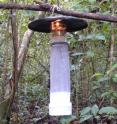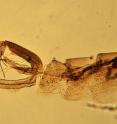Sand fly barcoding in Panama reveals Leishmania strain and its potential control
In the first survey of sand flies in Panama to use genetic barcoding, scientists at the Smithsonian Tropical Research Institute and Gorgas Memorial Laboratories identified 20 sand fly species from Barro Colorado Island. Two species carried Leishmania naiffi, a parasite that causes cutaneous leishmaniasis: persistent, itchy skin lesions. Three species carried Wolbachia, a bacterial parasite of insects that could contribute to a strategy to control the flies and limit disease transmission. "We used DNA barcoding—sequencing a particular gene of the blood-feeding flies we collected—to identify the 20 fly species; two species could not be distinguished visually," said Don Windsor, a Smithsonian scientist, who collaborated with STRI interns Jorge Azpurua, Dianne de la Cruz and Anayansi Valderama. "By characterizing another gene fragment from the nucleus of Leishmania, we discovered which fly species carried this disease-causing trypanosome."
Leishmaniasis is not new in central Panama—it poses a long-standing health risk to residents and visitors in the region. L. naiffi, the species carried by the flies in this survey, was previously known only to be in the Caribbean and the Amazon. "Other species of Leishmania and the blood-feeding flies that transmit them are endemic in central Panama," said Windsor. "Either L. naiffi was here undetected, or it could be a recent introduction carried by animals or people coming into Panama. Another explanation is that it is gradually moving northward from South America into Central America."
Researchers hope that the presence of Wolbachia in the same species of flies that carry Leishmania may be useful in disease control. Wolbachia bacteria infect the flies and are passed readily from generation to generation. Wolbachia affects the flies' ability to reproduce and has been proposed as a possible biological control of other insect pests.
Windsor emphasized that common preventative measures such as wearing insect repellent and long-sleeved shirts and pants when going out at dawn or dusk should be standard practice for residents, researchers and tourists who visit lowland tropical forests where Leishmania is endemic.
Source: Smithsonian Tropical Research Institute
Other sources
- Sand fly barcoding in Panama reveals Leishmania strain and its potential controlfrom Science BlogTue, 6 Apr 2010, 18:42:11 UTC
- Sand fly barcoding in Panama reveals Leishmania strain and its potential controlfrom PhysorgTue, 6 Apr 2010, 17:35:12 UTC


